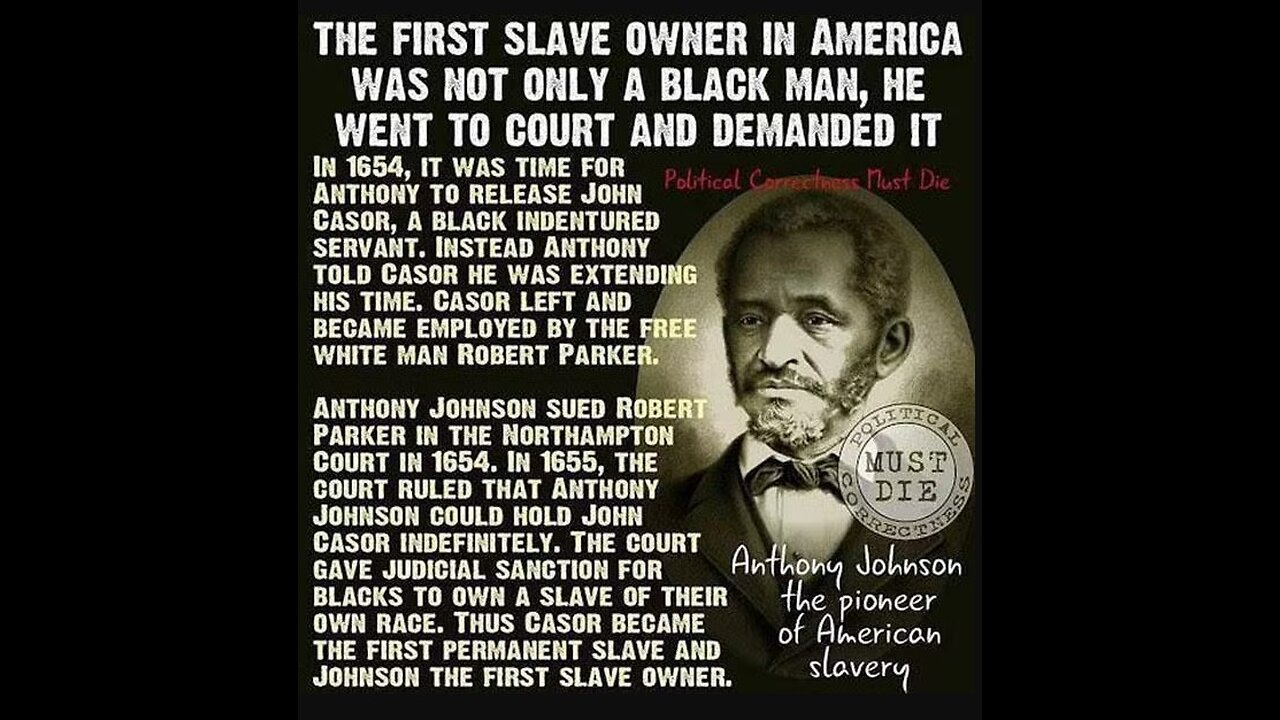Premium Only Content

Facts About Slavery Never Mentioned By Antifa/Black Lives Matter In School Lesson
The Irish were slaves too; slaves had it better than Northern factory workers; black people fought for the Confederacy; and other lies, half-truths, and irrelevancies. A certain resistance to discussion about the toll of American slavery isn’t confined to the least savory corners of the Internet. Last year, in an unsigned (and now withdrawn) review of historian Ed Baptist’s book The Half Has Never Been Told, the Economist took issue with Baptist’s “overstated” treatment of the topic, arguing that the increase in the country’s economic output in the 19th century shouldn’t be chalked up to black workers’ innovations in the cotton field but rather to masters treating their slaves well out of economic self-interest—a bit of seemingly rational counterargument that ignores the moral force of Baptist’s narrative, while making space for the fantasy of kindly slavery. In a June column on the legacy of Robert E. Lee that was otherwise largely critical of the Confederate general, New York Times op-ed columnist David Brooks wrote that, though Lee owned slaves, he didn’t like owning slaves—a biographical detail whose inclusion seemed to imply that Lee’s ambivalence somehow made his slaveholding less objectionable. And in an August obituary of civil rights leader Julian Bond, the Times called his great-grandmother Jane Bond “the slave mistress of a Kentucky farmer”—a term that accords far too much agency to Bond’s ancestor and too little blame to the “farmer” who enslaved her.
While working on our Slate Academy podcast, The History of American Slavery, we encountered many types of slavery denial—frequently disguised as historical correctives and advanced by those who want to change (or end) conversation about the deep impact of slavery on American history. We’d like to offer counterarguments—some historical, some ethical—to the most common misdirection's that surface in conversations about slavery.
Black people enslaved each other in Africa, and black people worked with slave traders too and Now Reparations for slavery is an important issue for African-Americans, with estimates ranging from $142,000 (equivalent to $162,000 in 2021) up to $17 trillion. Black liberals (84%) and moderates (79%) are more likely than conservatives (71%) to say that descendants of the enslaved should be repaid and Black adults who say they’re registered to vote (80%) are more likely than those unregistered (72%) to support reparations for slavery.
If we’re talking about slavery as it was practiced on Africans in the United States—that is, hereditary chattel slavery—then the answer is a clear no. As historian and public librarian Liam Hogan writes in a paper titled “The Myth of ‘Irish Slaves’ in the Colonies,” “Persons from Ireland have been held in various forms of human bondage throughout history, but they have never been chattel slaves in the West Indies.” Nor is there any evidence of Irish chattel slavery in the North American colonies. There were a large number of Irish indentured servants, and there were cases in which Irish men and women were sentenced to indentured servitude in the “new world” and forcibly shipped across the Atlantic. But even involuntary laborers had more autonomy than enslaved Africans, and the large majority of Irish indentured servants came here voluntarily.
Which raises a question: Where did the myth of Irish slavery come from? A few places. The term “white slaves” emerged in the 17th and 18th centuries, first as a derogatory term for Irish laborers—equating their social position to that of slaves—later as political rhetoric in Ireland itself, and later still as Southern pro-slavery propaganda against an industrialized North. More recently, Hogan notes, several sources have conflated indentured servitude with chattel slavery in order to argue for a particular Irish disadvantage in the Americas, when compared to other white immigrant groups. Hogan cites several writers—Sean O’Callaghan in To Hell or Barbados and Don Jordan and Michael Walsh in White Cargo: The Forgotten History of Britain’s White Slaves in America—who exaggerate poor treatment of Irish indentured servants and intentionally conflate their status with African slaves. Neither of the authors “bother to inform the reader, in a coherent manner, what the differences are between chattel slavery and indentured servitude or forced labor,” writes Hogan.
This is an important point. Indentured servitude was difficult, deadly work, and many indentured servants died before their terms were over. But indentured servitude was temporary, with a beginning and an end. Those who survived their terms received their freedom. Servants could even petition for early release due to mistreatment, and colonial lawmakers established different, often lesser, punishments for disobedient servants compared to disobedient slaves. Above all, indentured servitude wasn’t hereditary. The children of servants were free; the children of slaves were property. To elide this is to diminish the realities of chattel slavery, which—perhaps—is one reason the most vocal purveyors of the myth are neo-Confederate and white supremacist groups.
Bottom line: Even if many Irish immigrants faced discrimination and hard lives on these shores, it doesn’t change the fact that American slavery—hereditary and race-based—was a massive institution that shaped and defined the political economy of colonial America, and later, the United States. Nor does it change the fact that this institution left a profound legacy for the descendants of enslaved Africans, who even after emancipation were subject to almost a century of violence, disenfranchisement, and pervasive oppression, with social, economic, and cultural effects that persist to the present.
In a piece published in Vice magazine in 2005 (and still available on the Vice website), comedian Jim Goad offers a series of “feel better about your history, white kids” arguments. One of his salvos: “Slavery was common throughout Africa, with entire tribes becoming enslaved after losing battles. Tribal chieftains often sold their defeated foes to white slave-traders.”
Is it true?: This is certainly true. But, as historian Marcus Rediker writes, the “ancient and widely accepted institution” of enslavement in Africa was exacerbated by the European presence. Yes, European slave traders entered “preexisting circuits of exchange” when they arrived in the 16th century. But European demand changed the shape of this market, strengthening enslavers and ensuring that more and more people would be carried away. “[European] slave-ship captains wanted to deal with ruling groups and strong leaders, people who could command labor resources and deliver the ‘goods,’ ” Rediker writes, and European money and technology further empowered those who were already dominant, encouraging them to enslave greater numbers. Both the social structures and infrastructure that enabled African systems of enslavement were strengthened by the transatlantic slave trade.
Bottom line: Why should this matter? This is a classic “two wrongs make a right” ethical proposition. Even if Africans (or Arabs, or Jews) colluded in the slave trade, should white Americans be entitled to do whatever they pleased with the people who were unlucky enough to fall victim?
It depends on how you parse the timeline. Anthony Johnson, the black ex–indentured servant whose bio opened the first episode of our podcast, did sue to hold John Casor for life in 1653, and the resulting civil court decision remanding Casor to Johnson’s ownership was (as historian R. Halliburton Jr. writes) “one of the first known legal sanctions of slavery” in the colonies. That phrase—“one of”—is crucial. The ship Desire brought a cargo of Africans from Barbados to Boston in 1634; these people were sold as slaves. In 1640 John Punch, a runaway servant of African descent, was sentenced to lifelong slavery in Virginia, while the two European-born companions who fled with him had their indentures extended. In 1641, the passage of the Body of Liberties provided legal sanction for the slave trade in the Massachusetts Bay Colony. (N.B.: The image in the meme above isn’t of Anthony Johnson. There were no photographers in 17th-century Virginia.)
Whether or not Anthony Johnson was the first American slaveholder, he was certainly not the last black person to own slaves. “It is a very sad aspect of African-American history that slavery sometimes could be a colorblind affair,” writes Henry Louis Gates Jr. on the Root, in a fascinating piece about the history of black slaveholders in the United States. Some black slaveholders bought family members, though this humanitarian arrangement doesn’t account for all of the history of black slaveholding, as Gates points out.
Bottom line: Even if Anthony Johnson was the first person in the North American colonies to hold a slave—even if many black people across the years held slaves—that doesn’t erase the fact that it was the racially based system of hereditary slavery that harmed the vast majority of black people living within it. The fact that some members of an oppressed class participate in oppression doesn’t excuse that oppression.
“Slaves were better off than some poor people working in Northern or English factories. At least they were given food and a place to stay.”
Is it true?: It was undeniably hard to be a factory worker in the 19th century. White adults (and children) labored in dangerous environments and were often hungry. But slaves were hardly in a better position.
While it makes some intuitive sense that a person would be rationally motivated to take care of his or her “property,” as the Economist’s reviewer suggested, historians have found that American slaveholders were apt to provide minimum levels of food and shelter for enslaved people. They considered black people’s palates to be less refined than white people’s, and this justified serving a monotonous diet of pork and cornmeal. Enslaved workers were expected to supplement their diets when they could, by tending their own vegetable gardens and hunting or trapping—more work to be added to their already heavy loads. Evidence shows that many enslaved people suffered from diseases associated with malnutrition, including pellagra, rickets, scurvy, and anemia.
Even if an enslaved person in the United States landed in a relatively “good” position—owned by a slaveholder who was inclined to feed workers well and be lenient in punishment—he was always subject to sale, which could happen because of death, debt, arguments in the family, or whim. Since very few laws regulated slaveholders’ treatment of enslaved people, there would be no guarantee that the next place the enslaved person landed would be equally comfortable—and the enslaved had limited opportunity, short of running away or resisting, to control the situation.
Bottom line: This is another case of the “two wrongs” fallacy. We could compare levels of mistreatment of Northern factory workers and Southern enslaved laborers and find that each group lived with hunger and injury; both findings are dismaying. But this is a distraction from the real issue: Slavery, as a system, legalized and codified the slaveholder’s control over the enslaved person’s body.
“Only a small percentage of Southerners owned slaves.”
“The vast majority of soldiers in the Confederate Army were simple men of meager income,” rather than wealthy slaveholders, writes the anonymous author of a widely-circulated Confederate History “fact sheet.”
Is it true?: According to the 1860 census, taken just before the Civil War, more than 32 percent of white families in the soon-to-be Confederate states owned slaves. Of course, this is an average, and different states had different levels of slaveholding. In Arkansas, just 20 percent of families owned slaves; in South Carolina, it was 46 percent; in Mississippi, it was 49 percent.
By most measures, this isn’t “small”—it’s roughly the same percentage of Americans who, today, hold a college degree. The large majority of slaveholding families were small farmers and not the major planters who dominate our image of “slavery.”
Typically, this fact is used to suggest that the Civil War was not about slavery. If so few Southerners owned slaves, goes the argument, then the war had to be about something else (namely, the sanctity of states’ rights). But, as historian Ira Berlin writes, the slave South was a slave society, not just a society with slaves. Slavery was at the foundation of economic and social relations, and slave-ownership was aspirational—a symbol of wealth and prosperity. Whites who couldn’t afford slaves wanted them in the same way that, today, most Americans want to own a home.
Bottom line: Slavery was the basis of white supremacy, which united all whites in a racist hierarchy. “[T]he existing relation between the two races in the South,” argued South Carolina Sen. John C. Calhoun in 1837, “forms the most solid and durable foundation on which to rear free and stable political institutions.” Many whites couldn’t imagine Southern society without slavery. And when it was threatened, those whites—whether they owned slaves or not—took up arms to defend their “way of life.”
There’s no question that this is true. As historians Ed Baptist and Sven Beckert show in their respective books, American slavery was an economic engine for the global economy. The South’s production of cotton drove industrialization and fueled a massive commodities market that transformed the world. Naturally, this meant that slavery was vital to Northern financial and industrial interests. It’s no coincidence, for instance, that New York City was among the most pro-Southern cities in the North during the Civil War; slavery was key to its economic success. In any honest conversation about American slavery, we have to look at the tight economic links between North and South and the degree to which the entire country was complicit in the enterprise.
Bottom line: Often, this line comes from Southern defenders, who want to emphasize Northern complicity. But the two types of historical guilt aren’t mutually exclusive. It’s true that the North played a major role in sustaining the slave economy. It’s also true that slavery was based in the American South; that it formed the basis of Southern society; that white Southerners were its most fervent defenders; and that those Southerners would eventually fight a war to preserve and expand the institution.
“Black people fought for the Confederacy.” - “Historical fact shows there were Black Confederate soldiers. These brave men fought in the trenches beside their White brothers, all under the Confederate Battle Flag,” reads a statement from the South Carolina chapter of the Sons of Confederate Veterans.
Is it true?: Here is a case where rhetorical precision is key. Did blacks serve in the Confederacy? Absolutely: As enslaved people, countless black Americans cooked, cleaned, and worked for Confederate regiments and their officers. But they didn’t fight; there’s no evidence that black Americans—enslaved or free—fought Union soldiers under Confederate banners.
Toward the end of the war, a desperate Confederate Congress allowed its army to enlist enslaved Africans who had been freed by their masters. A small number of black soldiers were trained, but there’s no evidence they saw action. And even this measure was divisive: Opponents attacked it as a betrayal of the Confederacy’s aim and purpose. “You cannot make soldiers of slaves, or slaves of soldiers,” declared Howell Cobb, president of the Provisional Confederate State Congress that drafted the Confederate States of America constitution. “The day you make a soldier of them is the beginning of the end of the Revolution. And if slaves seem good soldiers, then our whole theory of slavery is wrong.”
The myth is a product of the post-war period, when former Confederate leaders worked to retroactively redefine secession from a movement to preserve slavery to a fight for abstract “state’s rights” and a hazy “Southern way of life.”
Bottom line: Even if there were black soldiers in the Confederate army, it doesn’t change the truth of the Confederacy: Its goal was the protection and expansion of slavery. The institution was protected in the Confederate constitution. “Our new government is founded upon … the great truth that the negro is not equal to the white man; that slavery subordination to the superior race is his natural and normal condition,” said Confederate vice president Alexander Stephens in his “Cornerstone Speech.” “This, our new government, is the first, in the history of the world, based upon this great physical, philosophical, and moral truth.”
https://www.exposingtheirlies.com/post/some-covid-19-horror-stories-you-may-have-missed
So, like you were talking about the girl with meningitis vaccine? This is going to be even worse. So people have got to make some serious spiritual decisions about this…Are you going to say, ‘Oh, I want to get the vaccine so I can get on an airplane,’ or ‘So I can go out to eat,’ or I can keep my job.’ That gets a little harder. Or ‘So I can continue in professional school,’ which gets a little bit harder. “People are going to have to start making some really hard spiritual decisions about this.
Central to the idea of the American Dream lies an assumption that we all have an equal opportunity to generate the kind of wealth that brings meaning to the words “life, liberty and the pursuit of happiness,” boldly penned in the Declaration of Independence. The American Dream portends that with hard work, a person can own a home, start a business, and grow a nest egg for generations to draw upon. This belief, however, has been defied repeatedly by the United States government’s own decrees that denied wealth-building opportunities to Black Americans.
Today, the average white family has roughly 10 times the amount of wealth as the average Black family. White college graduates have over seven times more wealth than Black college graduates. Making the American Dream an equitable reality demands the same U.S. government that denied wealth to Blacks restore that deferred wealth through reparations to their descendants in the form of individual cash payments in the amount that will close the Black-white racial wealth divide. Additionally, reparations should come in the form of wealth-building opportunities that address racial disparities in education, housing, and business ownership.
In 1860, over $3 billion was the value assigned to the physical bodies of enslaved Black Americans to be used as free labor and production. This was more money than was invested in factories and railroads combined. In 1861, the value placed on cotton produced by enslaved Blacks was $250 million. Slavery enriched white slave owners and their descendants, and it fueled the country’s economy while suppressing wealth building for the enslaved. The United States has yet to compensate descendants of enslaved Black Americans for their labor. Nor has the federal government atoned for the lost equity from anti-Black housing, transportation, and business policy. Slavery, Jim Crow segregation, anti-Black practices like redlining, and other discriminatory public policies in criminal justice and education have robbed Black Americans of the opportunities to build wealth (defined as assets minus debt) afforded to their white peers.
Bootstrapping isn’t going to erase racial wealth divides. As economists William “Sandy” Darity and Darrick Hamilton point out in their 2018 report, What We Get Wrong About Closing the Wealth Gap, “Blacks cannot close the racial wealth gap by changing their individual behavior –i.e. by assuming more ‘personal responsibility’ or acquiring the portfolio management insights associated with ‘[financial] literacy.’” In fact, white high school dropouts have more wealth than Black college graduates. Moreover, the racial wealth gap did not result from a lack of labor. Rather, it came from a lack of financial capital.
Not only do racial wealth disparities reveal fallacies in the American Dream, the financial and social consequences are significant and wide-ranging. Wealth is positively correlated with better health, educational, and economic outcomes. Furthermore, assets from homes, stocks, bonds, and retirement savings provide a financial safety net for the inevitable shocks to the economy and personal finances that happen throughout a person’s lifespan.
Recessions impact everyone, but wealth is distributed quite unevenly in the U.S. The woeful inadequacy of a government-sponsored safety net was made apparent in the wake of economic disasters like the 2008 housing crisis and natural ones like Hurricane Katrina in 2005. Those who can draw upon the equity in a home, savings, and securities are able to recover faster after economic downturns than those without wealth. The lack of a social safety net and the racial wealth divide are currently on display amid the COVID-19 crisis. Disparities in access to health care along with inequities in economic policies combine to make Black people more vulnerable to negative consequences than white individuals.
Below, we provide a history of reparations in the United States, missed opportunities to redress the racial wealth gap, and specific details of a viable reparations package for Black Americans.
History of reparations in the United States - Reparations—a system of redress for egregious injustices—are not foreign to the United States. Native Americans have received land and billions of dollars for various benefits and programs for being forcibly exiled from their native lands. For Japanese Americans, $1.5 billion was paid to those who were interned during World War II. Additionally, the United States, via the Marshall Plan, helped to ensure that Jews received reparations for the Holocaust, including making various investments over time. In 1952, West Germany agreed to pay 3.45 billion Deutsche Marks to Holocaust survivors.
Black Americans are the only group that has not received reparations for state-sanctioned racial discrimination, while slavery afforded some white families the ability to accrue tremendous wealth. And, we must note that American slavery was particularly brutal. About 15 percent of the enslaved shipped from Western Africa died during transport. The enslaved were regularly beaten and lynched for frivolous infractions. Slavery also disrupted families as one in three marriages were split up and one in five children were separated from their parents. The case for reparations can be made on economic, social, and moral grounds. The United States had multiple opportunities to atone for slavery—each a missed chance to make the American Dream a reality—but has yet to undertake significant action.
Missed policy opportunities to atone for slavery with reparations 40 Acres and a Mule. The first major opportunity that the United States had and where it should have atoned for slavery was right after the Civil War. Union leaders including General William Sherman concluded that each Black family should receive 40 acres. Sherman signed Field Order 15 and allocated 400,000 acres of confiscated Confederate land to Black families. Additionally, some families were to receive mules left over from the war, hence 40 acres and a mule.
Yet, after President Abraham Lincoln’s assassination, President Andrew Johnson reversed Field Order 15 and returned land back to former slave owners. Instead of giving Blacks the means to support themselves, the federal government empowered former enslavers. For example, in Washington D.C., slave owners were actually paid reparations for lost property—the formally enslaved. This practice was also common in nearby states. Many Black Americans with limited work options returned as sharecroppers to till the same land for the very slave owners to whom they were once enslaved. Slave owners not only made money off the chattel enslavement of Black Americans, but they then made money multiple times over off the land that the formerly enslaved had no choice but to work.
The New Deal - There’s never a bad time to do what’s morally right, but the United States has had prime opportunities to atone for slavery. In the 1930s, the United States was reeling from the 1929 stock market crash and was firmly engulfed in the Great Depression. The Franklin Roosevelt administration implemented a series of policies as part of his New Deal legislation, estimated to cost roughly $50 billion then, to catapult the country out of depression. Current estimates price the New Deal at about $50 trillion.
Two particular policies of the New Deal fell short in redressing American’s racial wrongs—the G.I. Bill and Social Security. Though white and Black Americans fought in WWII, Black veterans could not redeem their post-war benefits like their white peers. While the G.I. Bill was mandated federally, it was implemented locally. The presence of racial housing covenants and redlining among local municipalities prohibited Blacks from utilizing federal benefits. White soldiers were afforded the opportunity to build wealth by sending themselves and their children to college and by obtaining housing and small business grants.
Regarding Social Security, two key professions that would have improved equity in America were excluded from the legislation—domestic and farm workers. These omissions effectively excluded 60 percent of Blacks across the U.S. and 75 percent in southern states who worked in these occupations. Roosevelt bargained these exclusionary provisions in the legislation on the backs of Black veterans and workers in order to propel mostly white America out of the Great Depression.
There are other policies and practices that contributed to racial wealth gap. Government-sanctioned discrimination related to the 1862 Homestead Act, redlining, restrictive covenants, and convict leasing blocked Blacks from the ability to gain wealth at similar rates as whites. Separate from slavery, damages should be awarded to Black people who were harmed by these policies and practices.
Reparations for slavery and anti-Black policies - We know the monetary value that was placed on enslaved Blacks and the productivity of their labor, as well as the amount of the racial wealth gap. We’ve seen other groups receive restitutions while the federal government pulled back reparations for Black Americans. Accordingly, if we want to close the racial wealth gap and live up to our moral creed to protect “life, liberty and the pursuit of happiness,” a federal reparations package for Black Americans is in order. This package should include individual and collective public benefits that simultaneously builds wealth and eliminates debt among Black citizens. We assert that it should be similar to the Harriet Tubman Community Investment Act, which was recently heard before the Maryland General Assembly where Ray testified on its behalf. The Harriet Tubman Community Investment Act aims to atone for slavery and its legacy by addressing education, homeownership, and business ownership barriers.
Individual payments for descendants of enslaved Black Americans - The U.S. government owes lost wages as well as damages to the people it helped enslave. In addition to the lost wages, the accumulative amount of restitution for individuals should eliminate the racial wealth gap that currently exists. According to the Federal Reserve’s most recent numbers in 2016, based on the Survey of Consumer Finances, white families had the highest median family wealth at $171,000, compared to Black and Hispanic families, which had $17,600 and $20,700, respectively. College tuition to 4-year or 2-year colleges and universities for descendants of enslaved Black Americans
People should be able to use the tuition remission to obtain a bachelor’s degree or an associate’s/vocational or technical degree. Tuition should be available for public or private universities. Considering the racial gap in the ability to obtain degrees at private schools, this part of the package will further help to reduce racial disparities by affording more social network access and opportunity structures.
Student loan forgiveness for descendants of enslaved Black Americans - Student loan debt continues to be a significant barrier to wealth creation for Black college graduates. Among 25-55 year olds, about 40 percent of Blacks compared to 30 percent of whites have student loan debt. Blacks also have nearly $45,000 of student loan debt compared to about $30,000 for whites. Recent research finds that Blacks are more likely to be allocated unsubsidized loans. Furthermore, graduates of Historically Black Colleges and Universities, compared to Predominately White Institutions, are more likely to receive subprime loans with higher interest rates.
Universities including Georgetown and Princeton Theological Seminary, which is the second-oldest seminary in the country, are aiming to atone for the fact that the sale of slaves helped to fortify their university endowments and establish them as elite institutions of higher education on a global scale. Descendants of the slaves sold by Georgetown and Princeton Theological Seminary are now entitled to full rights and benefits bestowed by those universities to obtain degrees across the higher education pipeline. The Virginia state legislature voted for some of its state universities to atone for slavery with reparations. Other universities, along with state legislatures and the federal government, should follow suit.
Down payment grants and housing revitalization grants for descendants of enslaved Black Americans
Down payment grants will provide Black Americans with some initial equity in their homes relative to mortgage insurance loans. Housing revitalization grants will help Black Americans to refurbish existing homes in neighborhoods that have been neglected due to a lack of government and corporate investments in predominately Black communities. Given recent settlements for predatory lending, low and fixed interest rates as well as property tax caps in areas in which housing prices are significantly devalued should be part of the package. After accounting for factors such as housing quality, neighborhood quality, education, and crime, owner-occupied homes in Black neighborhoods are undervalued by $48,000 per home on average, amounting to a whopping $156 billion that homeowners would have received if their homes were priced at market rates, according to Brookings research.
As gentrification occurs, Blacks are typically priced out of neighborhoods they helped to maintain, while the historical and current remnants of redlining and restrictive covenants inhibited investments. Some Black Americans are being forced from their family home of decades because of tax increases as neighborhoods are gentrified. This is an important point because some 2020 Democratic presidential candidates aimed to redress the racial wealth gap by focusing on historically redlined districts. Perry’s research shows that these policies fall short of capturing a large segment of Black Americans.
Business grants for business starting up, business expansion to hire more employees, or purchasing property for descendants of enslaved Black Americans
Black-owned businesses are more likely to be located in predominately Black neighborhoods that need the infrastructure and businesses. However, Black business owners are still less likely to obtain capital from banks to make their businesses successful.
This reparations package for Black Americans is about restoring the wealth that has been extracted from Black people and communities. Still, reparations are all for naught without enforcement of anti-discrimination policies that remove barriers to economic mobility and wealth building. The architecture of the economy must change in order to create an equitable society. The racial wealth gap was created by racist policies. Federal intervention is needed to remove the racism that undergirds those polices. In some respects, the question of who should receive reparations is more controversial than what or how much people should be awarded.
Who should receive reparations? One key question after deciding what a reparations package should include is who should qualify. In short, a Black person who can trace their heritage to people enslaved in U.S. states and territories should be eligible for financial compensation for slavery. Meanwhile, Black people who can show how they were excluded from various policies after emancipation should seek separate damages. For instance, a person like Senator Cory Booker whose parents are descendants of slaves would qualify for slavery reparations whereas Senator Kamala Harris (Jamaican immigrant father and Indian immigrant mother) and President Barack Obama (Kenyan immigrant father and white mother) may seek redress for housing and/or education segregation. Sasha and Malia Obama (whose mother is Michelle Robinson Obama, a descendant of enslaved Africans) would qualify.
To determine qualification, birth records can initially be used to determine if a person was classified as Black American. Economist Sandy Darity asserts that people should show a consistent pattern of identification. Census records can then be used to determine if a person has consistently identified as Black American. Finally, DNA testing can be used as a supplement to determine lineage. This is how Senator Booker, who first introduced a reparations bill in the Senate, learned that his lineage stemmed from Sierra Leone.
Conclusion For the descendants of the 12.5 million Blacks who were shipped in chains from Western Africa, “America has a genetic birth defect when it comes to the question of race,” as stated recently by U.S. Representative Hakeem Jeffries. If America is to atone for this defect, reparations for Black Americans is part of the healing and reconciliation process.
With April 4 marking the fifty-second year since Dr. Martin Luther King, Jr. was assassinated in Memphis, we think it is appropriate to end with an oft-forgotten quote from Dr. King’s “I Have a Dream Speech” that he gave in 1963 in Washington, D.C. This statement is still one of the unfulfilled aspects of this policy-related speech:
We have come to our nation’s capital to cash a check. When the architects of our republic wrote the magnificent words of the Constitution and the Declaration of Independence, they were signing a promissory note to which every American was to fall heir. … It is obvious today that America has defaulted on this promissory note insofar as her citizens of color are concerned. Instead of honoring this sacred obligation, America has given the Negro people a bad check, a check which has come back marked “insufficient funds.” But we refuse to believe that the bank of justice is bankrupt.
Given the lingering legacy of slavery on the racial wealth gap, the monetary value we know that was placed on enslaved Blacks, the fact that other groups have received reparations, and the fact that Blacks were originally awarded reparations only to have them rescinded provide overwhelming evidence that it is time to pay reparations to the descendants of enslaved Blacks.
-
 2:19:00
2:19:00
What If Everything You Were Taught Was A Lie?
16 days agoExploring Tartaria Mysteries Ancient Maps You Were Never Meant To See Antarctica Our Hidden Earth
3.14K5 -
 LIVE
LIVE
Spartan
6 hours agoSpartan - Pro Halo Player for OMiT | Scrims vs ETHR
58 watching -
 57:56
57:56
ZeeeMedia
5 hours agoAmerica's AI Action Plan: Progress or Dystopian Nightmare? ft. Joe Allen | Daily Pulse Ep 74
7.66K2 -
 9:27
9:27
MattMorseTV
4 hours ago $0.34 earnedHe just lost EVERYTHING.
4.56K4 -
 7:15:42
7:15:42
StoneMountain64
8 hours agoWhy Everyone says WILDGATE is SO GOOD
3.34K -
 1:00:26
1:00:26
BonginoReport
10 hours agoWokeism Kills Late Night with Mike Crispi - Nightly Scroll w/ Hayley Caronia (Ep.98) - 07/25/2025
94.2K22 -
 7:36:47
7:36:47
Dr Disrespect
9 hours ago🔴LIVE - DR DISRESPECT - BATTLEFIELD BAD COMPANY 2 - FULL GAME
167K12 -
 1:18:27
1:18:27
Kim Iversen
1 day agoSudden Floods Everywhere…Is Weather Being Weaponized?
98.9K61 -
 LIVE
LIVE
HilketheHermit
2 hours agoAdventures on the High Seas with the guys(7): The Full Crew once again
7 watching -
 LIVE
LIVE
xXFadedAngelXx
3 hours agoRocket league with Tayte! then DAY 3! I'm addicted... (Zoo Tycoon 2 Radical Remake Mod)
17 watching